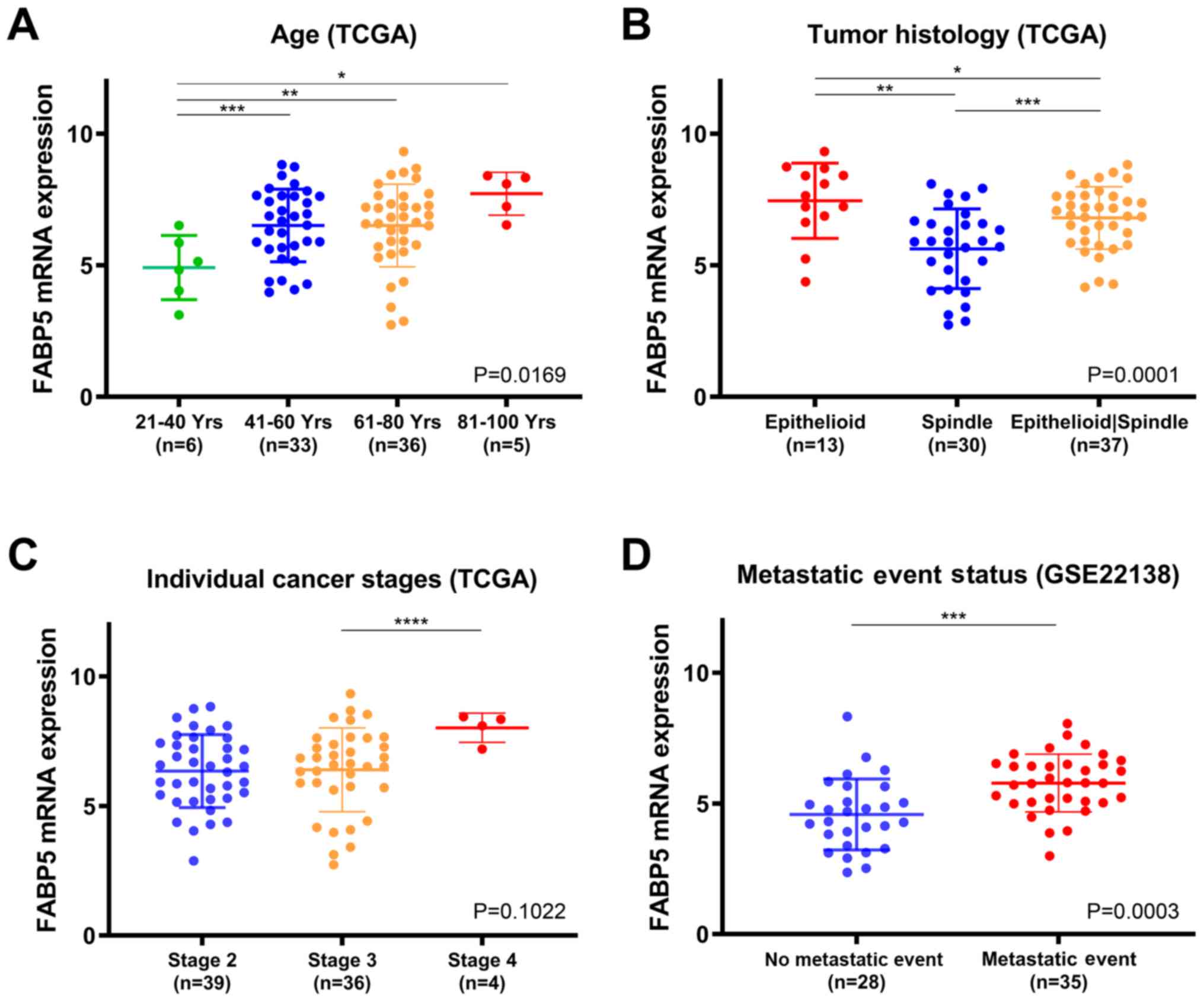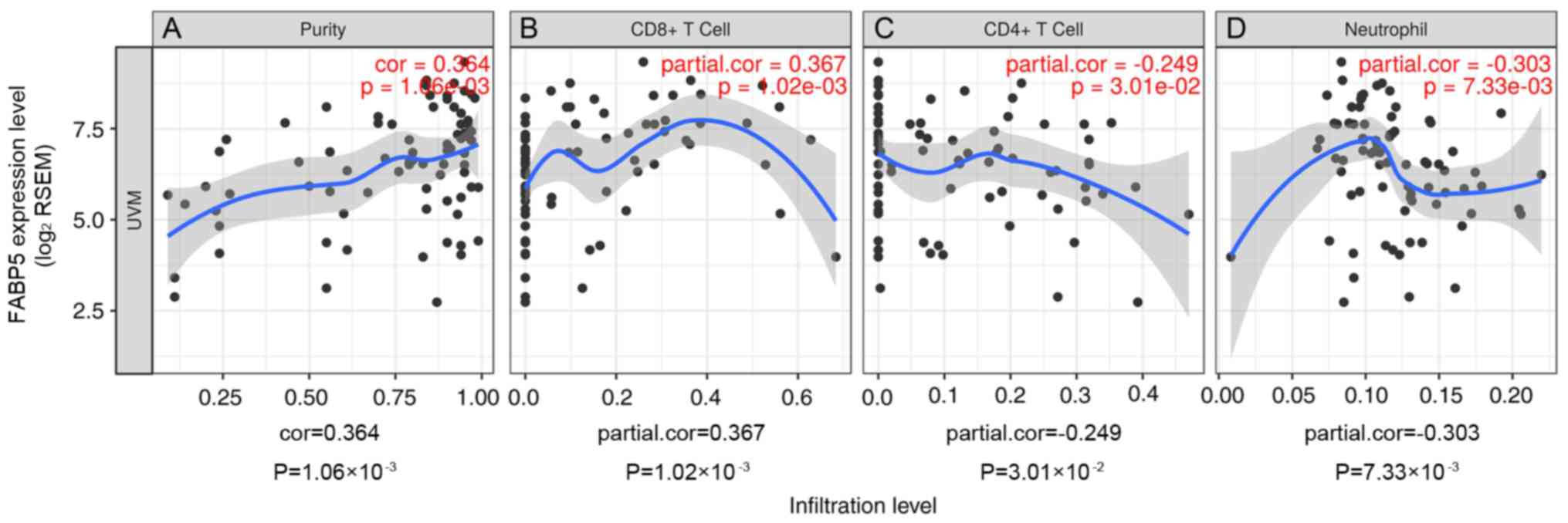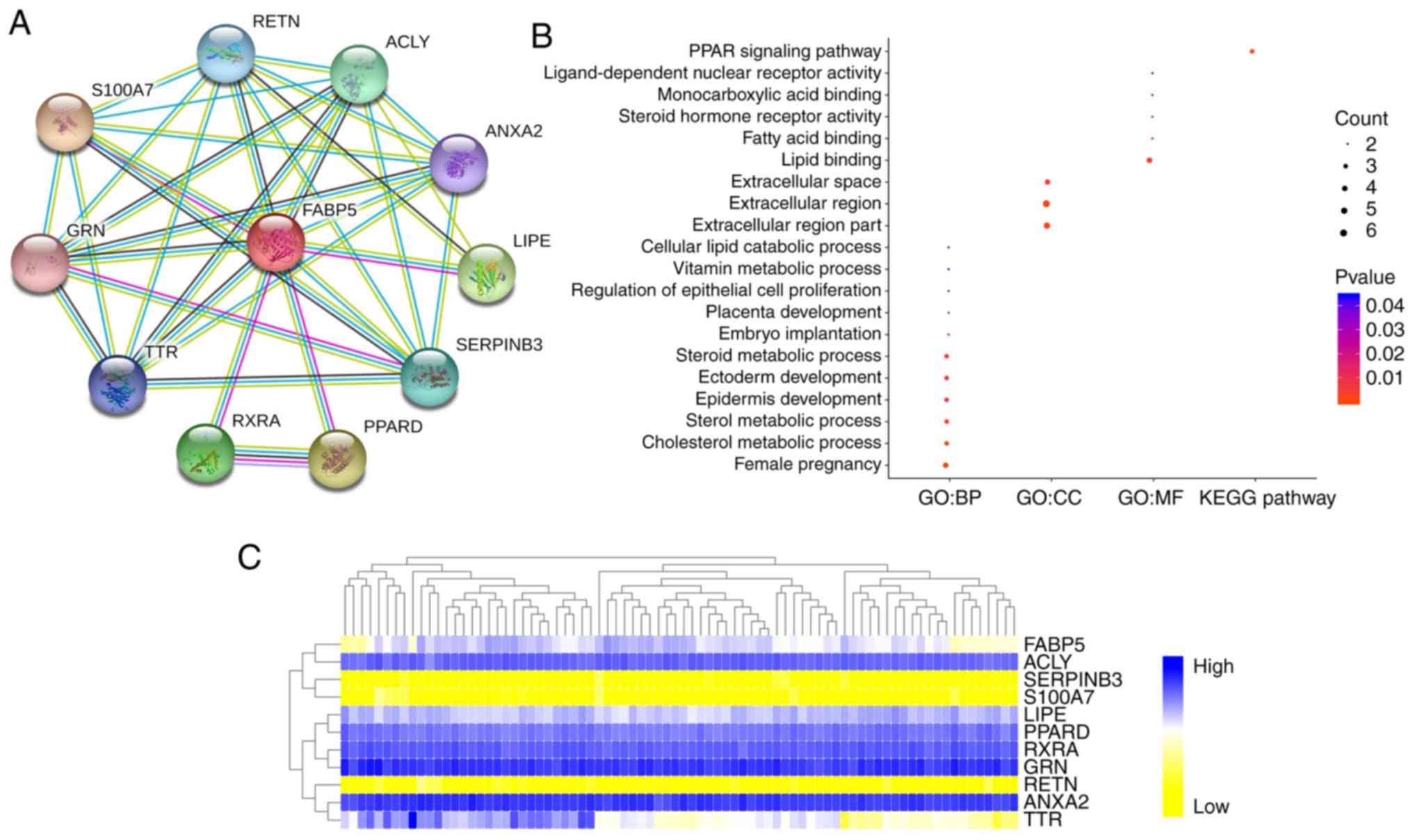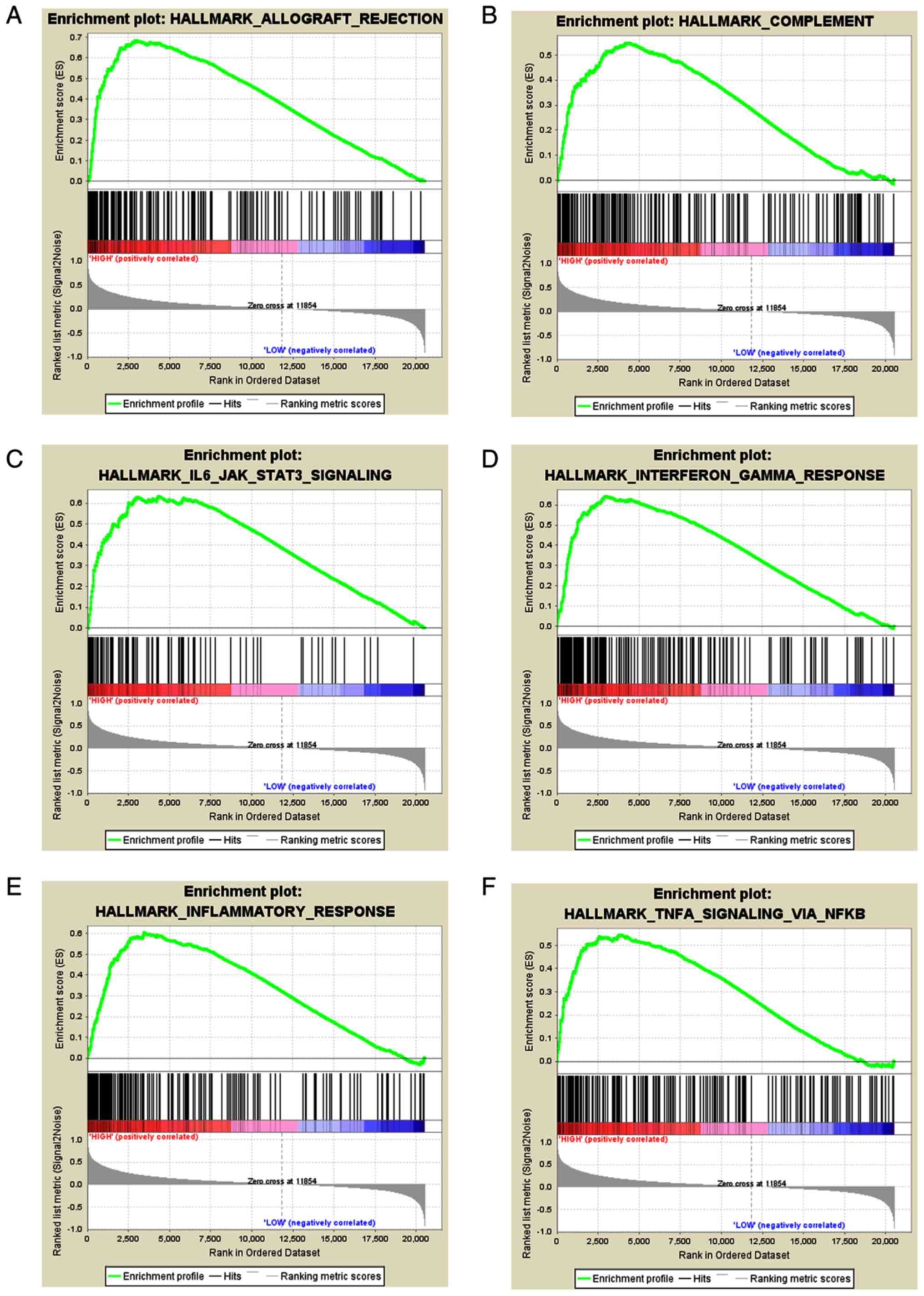|
1
|
Kaliki S and Shields CL: Uveal melanoma:
Relatively rare but deadly cancer. Eye (Lond). 31:241–257. 2017.
View Article : Google Scholar : PubMed/NCBI
|
|
2
|
Mahendraraj K, Lau CS, Lee I and
Chamberlain RS: Trends in incidence, survival, and management of
uveal melanoma: A population-based study of 7,516 patients from the
Surveillance, Epidemiology, and End Results database (1973–2012).
Clin Ophthalmol. 10:2113–2119. 2016. View Article : Google Scholar : PubMed/NCBI
|
|
3
|
Carvajal RD, Schwartz GK, Tezel T, Marr B,
Francis JH and Nathan PD: Metastatic disease from uveal melanoma:
Treatment options and future prospects. Br J Ophthalmol. 101:38–44.
2017. View Article : Google Scholar : PubMed/NCBI
|
|
4
|
Smit KN, Chang J, Derks K, Vaarwater J,
Brands T, Verdijk RM, Wiemer EAC, Mensink HW, Pothof J, de Klein A
and Kilic E: Aberrant MicroRNA expression and its implications for
uveal melanoma metastasis. Cancers (Basel). 11(pii): E8152019.
View Article : Google Scholar : PubMed/NCBI
|
|
5
|
Lorenzo D, Piulats JM, Ochoa M, Arias L,
Gutiérrez C, Català J, Cobos E, Garcia-Bru P, Dias B, Padrón-Pérez
N and Caminal JM: Clinical predictors of survival in metastatic
uveal melanoma. Jpn J Ophthalmol. 63:197–209. 2019. View Article : Google Scholar : PubMed/NCBI
|
|
6
|
Kawaguchi K, Kinameri A, Suzuki S, Senga
S, Ke Y and Fujii H: The cancer-promoting gene fatty acid-binding
protein 5 (FABP5) is epigenetically regulated during human prostate
carcinogenesis. Biochem J. 473:449–461. 2016. View Article : Google Scholar : PubMed/NCBI
|
|
7
|
Ohata T, Yokoo H, Kamiyama T, Fukai M,
Aiyama T, Hatanaka Y, Hatanaka K, Wakayama K, Orimo T, Kakisaka T,
et al: Fatty acid-binding protein 5 function in hepatocellular
carcinoma through induction of epithelial-mesenchymal transition.
Cancer Med. 6:1049–1061. 2017. View Article : Google Scholar : PubMed/NCBI
|
|
8
|
Pan L, Xiao H, Liao R, Chen Q, Peng C,
Zhang Y, Mu T and Wu Z: Fatty acid binding protein 5 promotes tumor
angiogenesis and activates the IL6/STAT3/VEGFA pathway in
hepatocellular carcinoma. Biomed Pharmacother. 106:68–76. 2018.
View Article : Google Scholar : PubMed/NCBI
|
|
9
|
Furuhashi M and Hotamisligil GS: Fatty
acid-binding proteins: Role in metabolic diseases and potential as
drug targets. Nat Rev Drug Discov. 7:489–503. 2008. View Article : Google Scholar : PubMed/NCBI
|
|
10
|
Senga S, Kobayashi N, Kawaguchi K, Ando A
and Fujii H: Fatty acid-binding protein 5 (FABP5) promotes
lipolysis of lipid droplets, de novo fatty acid (FA) synthesis and
activation of nuclear factor-kappa B (NF-κB) signaling in cancer
cells. Biochim Biophys Acta Mol Cell Biol Lipids. 1863:1057–1067.
2018. View Article : Google Scholar : PubMed/NCBI
|
|
11
|
Lv Q, Wang G, Zhang Y, Han X, Li H, Le W,
Zhang M, Ma C, Wang P and Ding Q: FABP5 regulates the proliferation
of clear cell renal cell carcinoma cells via the PI3K/AKT signaling
pathway. Int J Oncol. 54:1221–1232. 2019.PubMed/NCBI
|
|
12
|
Wang W, Chu HJ, Liang YC, Huang JM, Shang
CL, Tan H, Liu D, Zhao YH, Liu TY and Yao SZ: FABP5 correlates with
poor prognosis and promotes tumor cell growth and metastasis in
cervical cancer. Tumor Biol. 37:14873–14883. 2016. View Article : Google Scholar
|
|
13
|
Armstrong EH, Goswami D, Griffin PR, Noy N
and Ortlund EA: Structural basis for ligand regulation of the fatty
acidbinding protein 5, peroxisome proliferator-activated receptor
β/δ (FABP5-PPARβ/δ) signaling pathway. J Biol Chem.
289:14941–14954. 2014. View Article : Google Scholar : PubMed/NCBI
|
|
14
|
Jeong CY, Hah YS, Cho BI, Lee SM, Joo YT,
Jung EJ, Jeong SH, Lee YJ, Choi SK, Ha WS, et al: Fatty
acid-binding protein 5 promotes cell proliferation and invasion in
human intrahepatic cholangiocarcinoma. Oncol Rep. 28:1283–1292.
2012. View Article : Google Scholar : PubMed/NCBI
|
|
15
|
Kawaguchi K, Senga S, Kubota C, Kawamura
Y, Ke Y and Fujii H: High expression of fatty acid-binding protein
5 promotes cell growth and metastatic potential of colorectal
cancer cells. FEBS Open Bio. 6:190–199. 2016. View Article : Google Scholar : PubMed/NCBI
|
|
16
|
Tomczak K, Czerwińska P and Wiznerowicz M:
The cancer genome atlas (TCGA): An immeasurable source of
knowledge. Contemp Oncol (Pozn). 19:A68–A77. 2015.PubMed/NCBI
|
|
17
|
Camp RL, Dolled-filhart M and Rimm DL:
X-tile: A new bio-informatics tool for biomarker assessment and
outcome-based cut-point optimization. Clin Cancer Res.
10:7252–7259. 2004. View Article : Google Scholar : PubMed/NCBI
|
|
18
|
Laurent C, Valet F, Planque N, Silveri L,
Maacha S, Anezo O, Hupe P, Plancher C, Reyes C, Albaud B, et al:
High PTP4A3 phosphatase expression correlates with metastatic risk
in uveal melanoma patients. Cancer Res. 71:666–674. 2011.
View Article : Google Scholar : PubMed/NCBI
|
|
19
|
Rhodes DR, Yu J, Shanker K, Deshpande N,
Varambally R, Ghosh D, Barrette T, Pandey A and Chinnaiyan AM:
ONCOMINE: A cancer microarray database and integrated data-mining
platform. Neoplasia. 6:1–6. 2004. View Article : Google Scholar : PubMed/NCBI
|
|
20
|
Li T, Fan J, Wang B, Traugh N, Chen Q, Liu
JS, Li B and Liu XS: TIMER: A web server for comprehensive analysis
of tumor-infiltrating immune cells. Cancer Res. 77:e108–e110. 2017.
View Article : Google Scholar : PubMed/NCBI
|
|
21
|
Li B, Severson E, Pignon JC, Zhao H, Li T,
Novak J, Jiang P, Shen H, Aster JC, Rodig S, et al: Comprehensive
analyses of tumor immunity: Implications for cancer immunotherapy.
Genome Biol. 17:1742016. View Article : Google Scholar : PubMed/NCBI
|
|
22
|
Aran D, Sirota M and Butte AJ: Systematic
pan-cancer analysis of tumour purity. Nat Commun. 6:89712015.
View Article : Google Scholar : PubMed/NCBI
|
|
23
|
Franceschini A, Szklarczyk D, Frankild S,
Kuhn M, Simonovic M, Roth A, Lin J, Minguez P, Bork P, von Mering C
and Jensen LJ: STRING v9.1: Protein-protein interaction networks,
with increased coverage and integration. Nucleic Acids Res.
41:D808–D815. 2013. View Article : Google Scholar : PubMed/NCBI
|
|
24
|
Huang DW, Sherman BT, Tan Q, Collins JR,
Alvord WG, Roayaei J, Stephens R, Baseler MW, Lane HC and Lempicki
RA: The DAVID gene functional classification tool: A novel
biological module-centric algorithm to functionally analyze large
gene lists. Genome Biol. 8:R1832007. View Article : Google Scholar : PubMed/NCBI
|
|
25
|
Subramanian A, Tamayo P, Mootha VK,
Mukherjee S, Ebert BL, Gillette MA, Paulovich A, Pomeroy SL, Golub
TR, Lander ES and Mesirov JP: Gene set enrichment analysis: A
knowledge-based approach for interpreting genome-wide expression
profiles. Proc Natl Acad Sci USA. 102:15545–15550. 2005. View Article : Google Scholar : PubMed/NCBI
|
|
26
|
Dunn GP, Dunn IF and Curry WT: Focus on
TILs: Prognostic significance of tumor infiltrating lymphocytes in
human glioma. Cancer Immun. 7:122007.PubMed/NCBI
|
|
27
|
Azimi F, Scolyer RA, Rumcheva P, Moncrieff
M, Murali R, McCarthy SW, Saw RP and Thompson JF:
Tumor-infiltrating lymphocyte grade is an independent predictor of
sentinel lymph node status and survival in patients with cutaneous
melanoma. J Clin Oncol. 30:2678–2683. 2012. View Article : Google Scholar : PubMed/NCBI
|
|
28
|
Vichitvejpaisal P, Dalvin LA, Mazloumi M,
Ewens KG, Ganguly A and Shields CL: Genetic analysis of uveal
melanoma in 658 patients using the cancer genome atlas
classification of uveal melanoma as A, B, C, and D. Ophthalmology.
126:1445–1453. 2019. View Article : Google Scholar : PubMed/NCBI
|
|
29
|
Caltabiano R, Puzzo L, Barresi V, Ieni A,
Loreto C, Musumeci G, Castrogiovanni P, Ragusa M, Foti P, Russo A,
et al: ADAM 10 expression in primary uveal melanoma as prognostic
factor for risk of metastasis. Pathol Res Pract. 212:980–987. 2016.
View Article : Google Scholar : PubMed/NCBI
|
|
30
|
Broggi G, Musumeci G, Puzzo L, Russo A,
Reibaldi M, Ragusa M, Longo A and Caltabiano R: Immunohistochemical
expression of ABCB5 as a potential prognostic factor in uveal
melanoma. Appl Sci. 9:13162019. View Article : Google Scholar
|
|
31
|
Pan J, Dai Q, Zhang T and Li C: Palmitate
acid promotes gastric cancer metastasis via FABP5/SP1/UCA1 pathway.
Cancer Cell Int. 19:692019. View Article : Google Scholar : PubMed/NCBI
|
|
32
|
Ju J, Wang N, Wang J, Wu F, Ge J and Chen
F: 4-Amino-2-trifluoromethyl-phenyl retinate inhibits
proliferation, invasion, and migration of breast cancer cells by
independently regulating CRABP2 and FABP5. Drug Des Devel Ther.
12:997–1008. 2018. View Article : Google Scholar : PubMed/NCBI
|
|
33
|
Kaczocha M, Vivieca S, Sun J, Glaser ST
and Deutsch DG: Fatty acid-binding proteins transport
N-acylethanolamines to nuclear receptors and are targets of
endocannabinoid transport inhibitors. J Biol Chem. 287:3415–3424.
2012. View Article : Google Scholar : PubMed/NCBI
|
|
34
|
Siegenthaler G, Hotz R, Chatellard-Gruaz
D, Didierjean L, Hellman U and Saurat JH: Purification and
characterization of the human epidermal fatty acid-binding protein:
Localization during epidermal cell differentiation in vivo and in
vitro. Biochem J. 302:363–371. 1994. View Article : Google Scholar : PubMed/NCBI
|
|
35
|
Di-Poï N, Michalik L, Tan NS, Desvergne B
and Wahli W: The anti-apoptotic role of PPARbeta contributes to
efficient skin wound healing. J Steroid Biochem Mol Biol.
85:257–265. 2003. View Article : Google Scholar : PubMed/NCBI
|
|
36
|
Adhikary T, Brandt DT, Kaddatz K, Stockert
J, Naruhn S, Meissner W, Finkernagel F, Obert J, Lieber S, Scharfe
M, et al: Inverse PPARβ/δ agonists suppress oncogenic signaling to
the ANGPTL4 gene and inhibit cancer cell invasion. Oncogene.
32:5241–5252. 2013. View Article : Google Scholar : PubMed/NCBI
|
|
37
|
Wang D, Wang H, Guo Y, Ning W, Katkuri S,
Wahli W, Desvergne B, Dey SK and DuBois RN: Crosstalk between
peroxisome proliferator-activated receptor delta and VEGF
stimulates cancer progression. Proc Natl Acad Sci USA.
103:19069–19074. 2006. View Article : Google Scholar : PubMed/NCBI
|
|
38
|
Alshalalfa M, Bismar TA and Alhajj R:
Detecting cancer outlier genes with potential rearrangement using
gene expression data and biological networks. Adv Bioinformatics.
2012:3735062012. View Article : Google Scholar : PubMed/NCBI
|
|
39
|
Xu Y, Han W, Xu W, Wang Y, Yang XL, Nie
HL, Yao J, Shen GL and Zhang XF: Identification of differentially
expressed genes and functional annotations associated with
metastases ofthe uveal melanoma. J Cell Biochem. 120:19202–19214.
2019. View Article : Google Scholar : PubMed/NCBI
|
|
40
|
Morgan EA, Forootan SS, Adamson J, Foster
CS, Fujii H, Igarashi M, Beesley C, Smith PH and Ke Y: Expression
of cutaneous fatty acid-binding protein (C-FABP) in prostate
cancer: Potential prognostic marker and target for
tumourigenicity-suppression. Int J Oncol. 32:767–775.
2008.PubMed/NCBI
|
|
41
|
Kowalewska M, Radziszewski J, Goryca K,
Bujko M, Oczko-Wojciechowska M, Jarzab M, Siedlecki JA and
Bidzinski M: Estimation of groin recurrence risk in patients with
squamous cell vulvar carcinoma by the assessment of marker gene
expression in the lymph nodes. BMC Cancer. 12:2232012. View Article : Google Scholar : PubMed/NCBI
|
|
42
|
Schug TT, Berry DC, Toshkov IA, Cheng L,
Nikitin AY and Noy N: Overcoming retinoic acid-resistance of
mammary carcinomas by diverting retinoic acid from PPARbeta/delta
to RAR. Proc Natl Acad Sci USA. 105:7546–7551. 2008. View Article : Google Scholar : PubMed/NCBI
|
|
43
|
Levi L, Lobo G, Doud MK, Von Lintig J,
Seachrist D, Tochtrop GP and Noy N: Genetic ablation of the fatty
acid-binding protein FABP5 suppresses HER2-induced mammary
tumorigenesis. Cancer Res. 73:4770–4780. 2013. View Article : Google Scholar : PubMed/NCBI
|
|
44
|
Andreoli MT, Mieler WF and Leiderman YI:
Epidemiological trends in uveal melanoma. Br J Ophthalmol.
99:1550–1553. 2015. View Article : Google Scholar : PubMed/NCBI
|
|
45
|
Kaliki S, Shields CL and Shields JA: Uveal
melanoma: Estimating prognosis. Indian J Ophthalmol. 63:93–102.
2015. View Article : Google Scholar : PubMed/NCBI
|
|
46
|
Shields CL, Kaliki S, Furuta M, Mashayekhi
A and Shields JA: Clinical spectrum and prognosis of uveal melanoma
based on age at presentation in 8,033 cases. Retina. 32:1363–1372.
2012. View Article : Google Scholar : PubMed/NCBI
|
|
47
|
Kaliki S, Shields CL, Mashayekhi A, Ganesh
A, Furuta M and Shields JA: Influence of age on prognosis of young
patients with uveal melanoma: A matched retrospective cohort study.
Eur J Ophthalmol. 23:208–216. 2013. View Article : Google Scholar : PubMed/NCBI
|



















